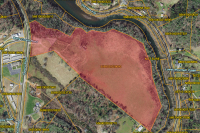Shelter at bear attack site now open
 Nearly a month after an Appalachian Trail thru-hiker found his night interrupted by an attacking bear, the backcountry shelter in the Great Smoky Mountains National Park where the incident occurred is open once more.
Nearly a month after an Appalachian Trail thru-hiker found his night interrupted by an attacking bear, the backcountry shelter in the Great Smoky Mountains National Park where the incident occurred is open once more.
Bradley Veeder, 49, had been asleep in his tent about 200 feet from the Spence Field Shelter on May 10 when he woke up to “a sharp pain in my right calf and an agonizing sensation like my calf was being squeezed in a vise,” as he described it in a written account of the incident. According to both Veeder and the park, his food and toiletries had been hung properly on bear cables, and his pack — which was in the tent with him — contained a small inventory of non-scented items.
After biting Veeder, the bear made repeated attacks on the tent before subsiding long enough for Veeder to make his way to the shelter, which is surrounded by chain-link fence to keep bears away. In the morning, he was evacuated from the backcountry on horseback and taken to Blount Memorial Hospital. Veeder has recovered and plans to get back on the A.T. as a southbound hiker later this summer.
The park, meanwhile, went to work to find the bear in question, closing the shelter and monitoring the area for bear activity. The first bear that returned to the area, a 400-pound male, was euthanized after park staff concluded there was a high likelihood this was the bear that had bitten Veeder. But DNA tests came back negative, causing sharp criticism from some people — especially considering that the wrong bear was euthanized the last time a bear injured a person, in June 2015.
“I understand we can’t have bears breaking into tents when people are in them. I understand that,” said Bill Lea, a wildlife photographer who’s spent thousands of hours observing bears in the wild. “But I think that if that animal needs to be eliminated, we need to make sure we’re eliminating the right animal.”
The park later tranquilized two other bears, each 200 pounds or less, fitting them with GPS collars and releasing them until DNA results came back. Those tests also yielded a negative result. The 400-pound bear could not be collared, park staff said, because its neck was too large to fit with a collar. It also could not be held captive while DNA results were processed because it was too big to transport through the 6 miles of backcountry separating the site from the road.
Related Items
The park reopened the Spence Field Shelter on Monday, June 6, after nearly a month of search efforts and a “reasonable closure period with no aggressive bear activity,” according to park spokeswoman Dana Soehn.
It is extremely rare for a black bear to hurt a human, and even rarer for that to happen when the human does not have food nearby. It’s so rare, in fact, that Lea has questioned whether the attack was in fact predatory, and not just an unfortunate incident provoked by undetected food residue on Veeder or his equipment.
One positive from the incident, according to the park, was the chance to exercise and strengthen its partnerships to get DNA results back faster than ever before. The park worked with both the forensic science program at Western Carolina University and Wildlife Forensics DNA Lab at East Stroudsburg University in Pennsylvania to compare DNA from the attacking bear to that of bears captured near the site. The combination of East Stroudsburg’s experience with black bear DNA and WCU’s proximity to the park means that the process now takes days rather than weeks. Faster results make it easier for bears suspected of being involved in aggressive incidents to be held until DNA confirmation comes back.
“Our park staff have worked diligently over the last year to develop new processes that allow us to minimize the possibility of euthanizing an uninvolved bear following an attack,” said Superintendent Cassius Cash. “We are glad to now have these new options afforded by quick DNA turnaround at WCU that allow us the opportunity to consider holding a bear while waiting for analysis.”
Be safe in the backcountry
Bears are numerous in the Smokies, but aggression toward humans is rare. However, May and June — when bears are active but berries aren’t yet ripe — are when interactions are most likely. To minimize the risk:
• Travel in groups of two or more. If you must hike alone, be sure to make noise frequently to alert any bears in the area that you’re coming their way.
• Carry bear spray where it will be easy to grab and know how to use it.
• When camping, hang all food, toiletries and anything else with an associated scent on a tree branch or bear cables. Even better, hang your whole pack. Cook food in a different area from where you pitch your tent and check your clothes for strong food odors.
• Stay at least 50 yards away from any bear you see.









